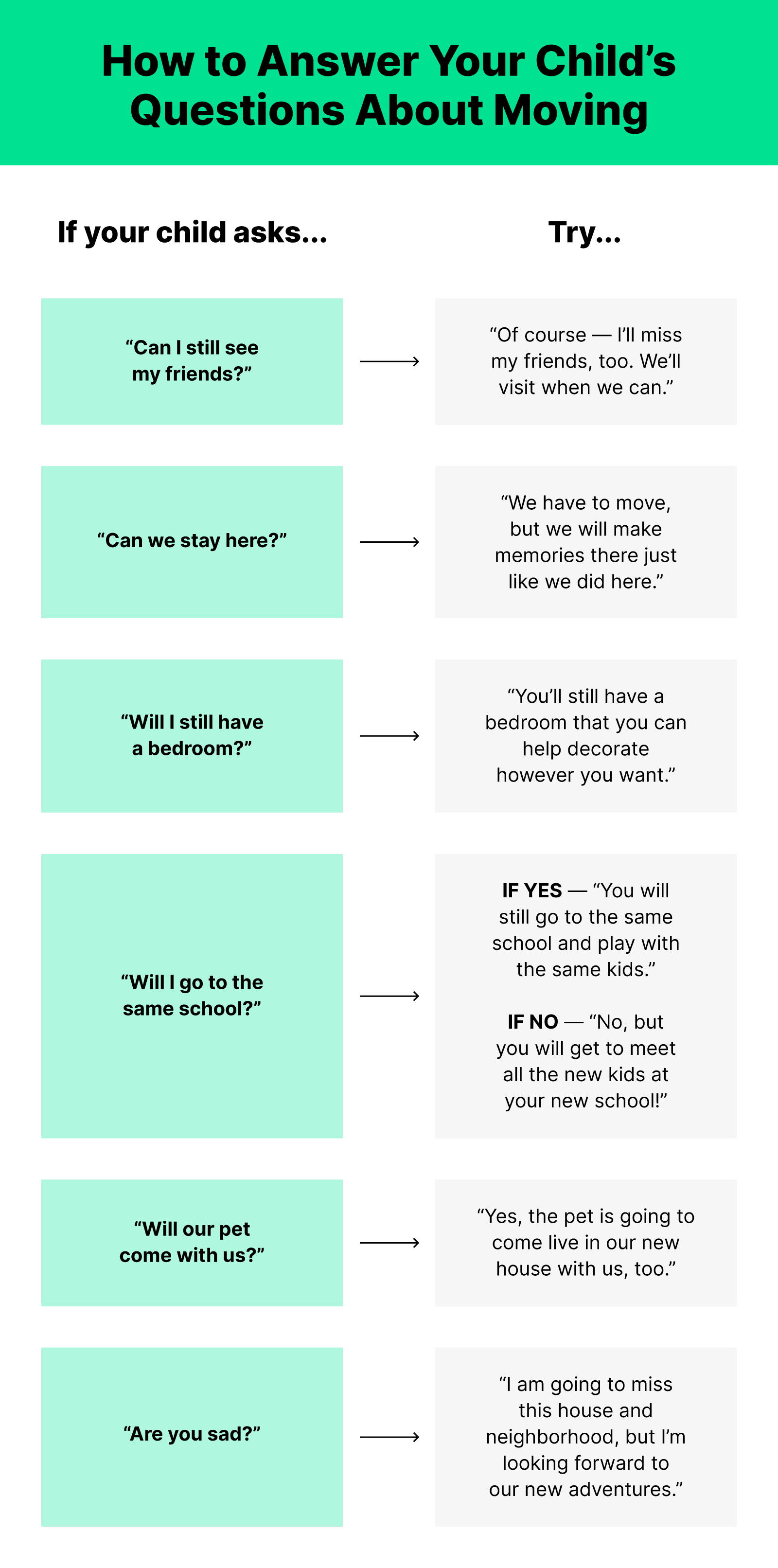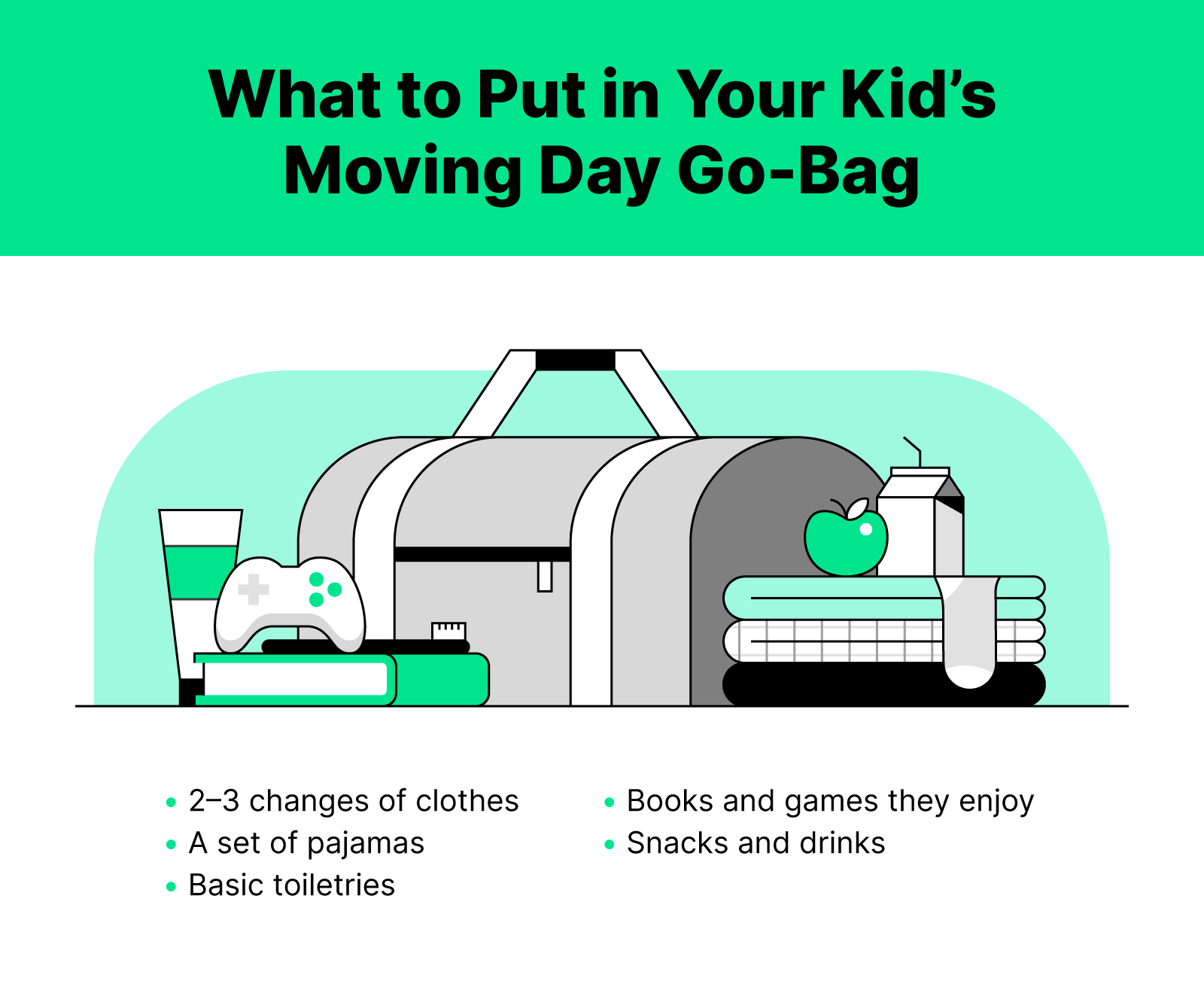A Stress-Free Guide to Moving With Children

The papers are signed and the U-Haul is booked: you’re moving. While the prospect of a new home is exciting and somewhat nerve-wracking, the pressure of moving with kids can add another layer of stress and uncertainty. But it doesn’t have to be that way.
Involving your kids in the moving process can help them get excited about their new home and understand the life changes that are about to occur. It’s best to let your children know as soon as possible about the upcoming relocation and prepare them by showing them that a move can be both challenging and fun.
So whether you’re moving into a fixer-upper or a brand new home, read on for tips about easing the tension and upping the anticipation while moving with kids.
Table of contents
- How to tell your child you’re moving
- What to do before the move
- What to do during the move
- What to do after the move
- Safety tips for moving with kids
- Infographic
How to tell your child you’re moving
It might be a difficult conversation to have, but it’s an important one. Telling your kids about your upcoming move with plenty of weeks to spare will help prepare them for the life change that they’re about to experience and can help them say their goodbyes to your current hometown.
Tell your child the details of the move as soon as possible, and don’t sugarcoat it. Tell them when and where you’re moving, and give them as much detail about why as you’re comfortable sharing with them at the time. Be prepared for an adverse reaction, and try to respond with positivity and understanding. Celebrate positive reactions or thoughts, and encourage excitement about the move.
Different age groups may respond to the news differently. For example, toddlers most likely won’t understand the upcoming change, and you may have to spend some time explaining to them what moving means. School-aged children and teenagers who have friends and routines in your current location may take the news harder and might require more encouragement and guidance throughout the process.
It’s essential to remain positive while also giving your children space to be sad or upset. Rather than forcing positivity, communicate with them about their feelings and help them navigate the situation. Forced positivity, also called toxic positivity, can be harmful to your kids. It’s best to teach them that experiencing negative emotions is normal and encourage them to communicate these feelings and work through them honestly.
Though you might not know all of the details immediately, sharing what you can, when you can will help the process be more manageable. The more information about the move the kids know at the beginning of it, the longer they’ll have to get used to the idea of moving houses. Plus, it will help them prepare for the changes that will come along with it.
What to do before the move
Just like you spend the weeks before move-in packing boxes, picking out paint colors, shopping for home insurance and getting ready to go, your kids should spend that time preparing as well. It’s best to tell your kids as soon as possible that you’re moving, so you can discuss and prepare for it together. Your kids could even help house hunt to make them feel more involved in the move.

Communicate
There are numerous studies about the importance of familial communication. And moving isn’t any different. You should communicate with your child throughout the moving process — from the second you tour your first home to the moment you unpack your last box. After the initial “we’re moving” bandaid is ripped off, continue to check in, talk about next steps and ask if they have any questions or concerns.
Get them excited
At first, a new home can seem overwhelming, and a new town or school with new kids to meet can be even more so. So getting them fired up can seem like a challenge. However, reframing the move as a thrilling new opportunity with activities to do, friends to make and sights to see can help your kids feel enthusiastic rather than apprehensive.
Help them pack
Any adult who has been through the moving process knows that the excitement of a move also means a lot of hard work packing and moving boxes. And we probably don’t have to tell you: kids don’t typically like organizing all of their belongings and putting them away. Luckily, you can help make the packing process more digestible for your kids by helping them do it. Show them how to pack a box, wrap their fragile toys and tape it closed.
You could also help sort which toys they want to keep and which ones they want to donate by setting up a “toy store.” Put your kids’ toys on a shelf and give them stickers to “purchase” any toys they want to keep. Whichever toys are left without stickers can be donated.
Visit your new home or hometown
Showing your kids exactly where you’re setting up home base can not only help them make sense of the move, but can also help get them excited about life in their new hometown. If you’re moving close enough to make it — or have the time to book a short trip — take your kids to your new town to get them acclimated and ready for the move.
If you can’t visit in person, you could “visit” your new hometown with technology! Log onto Google Maps and look at the neighborhood surrounding your home, parks and other fun areas in your new location.
What to do during the move
Moving day can be chaotic. But between the boxes, packing tape, moving trucks and making sure you check everything off your moving out checklist, it's crucial to keep your kids entertained, out of the way and feeling positive.
Hire a babysitter
It might seem silly to hire a babysitter while the family is all present, but this could be a smart move on a busy day for younger kids. A babysitter can take your children out for an ice cream cone or to the park or can keep them entertained in the backyard or another out-of-the-way area. This way, you can be confident that your kids are being looked after while you’re busy with other tasks.
Give them easy tasks to do
Older kids might want to get in on the action. For those that aren’t quite old enough to haul heavy boxes into the moving van, find more manageable tasks for them to do around the house. Arm them with a permanent marker and have them label where boxes should be placed in the new house, or assign them to unpack their room when the boxes are being moved in.

Pack an overnight bag
An overnight bag can be filled with books, toys and activities for your child that will keep them entertained between going to sleep on their last night in your old home and being all moved to your new home. Apart from the clothes they’ll need for moving day, make sure to include some books and other fun activities.
Play games
Games can help keep kids occupied and can even inspire them to do some work. Before the move, make a shortlist of items that can be found in your child’s bedroom boxes. When they start to unpack, give them the list as an unpacking scavenger hunt game, and reward them with a small toy or treat when they’ve found all the items. Alternatively, some moving companies provide activity packets for kids during the move — so ask yours if one is available ahead of time.
What to do after the move
After the moving truck disappears down the street, your family will be left with the excitement of a new home. Here’s how to help your kids adjust.
Establish a routine
After you’re done moving, it’s time for the dust to settle. Get back into a routine that your kids can recognize. Whether that’s soccer practice, family dinners or Sunday walks in the park, having something that your kids can look forward to and count on can help them settle into their new home and lifestyle.
Get involved in the community
Getting involved with the community can help the whole family — not just your kids — feel more at home in your new, well, home. Involving your kids in the community can mean everything from volunteering at a local nonprofit to signing up for a sports team or art class. You can even meet people by attending free community events or services at a local place of worship — whatever fits your lifestyle.
Check in
Though you might feel settled in once you’ve recycled your moving boxes and organized your silverware, your kids might not feel the same way. You should continue to check in with them for several weeks after moving to gauge how they’re adjusting to their new home. Ask what they like and what they feel uncomfortable about — and yes, even ask what they miss about their old home. These questions can help you navigate the transition to make it easier on your child.
Let them help decorate
A new bedroom can be an opportunity for your child to cultivate a space that is truly ‘theirs.’ Consider letting them help decorate in small ways that you’re comfortable with. This could mean letting them choose the color for their walls, hang up artwork that they like or pick out their own comforter and bedding. This way, their home will be a sanctuary that they can enjoy in your new house.
Safety tips for moving with kids
No matter how hard you try to manage them, kids have a way of getting into trouble. With so many people going in and out of your home, bustling past piles of stacked boxes and lugging heavy items to and fro, accidents can quickly happen. However, taking precautions before the move can reduce the risk of injury or accident.
The first step is to try to keep kids as occupied and away from the action as possible. This could mean clearing out a room of the house to use as a safe, empty kids’ zone to do activities while the move is happening. Alternatively, you could set up the safe zone in your backyard.
If the kids will be inside during the move, don’t stack boxes too high and avoid creating thin hallways or cramped spaces where there is a possibility that boxes or heavy items could topple over in the chaos. And if your kids are young, make sure to take the proper baby-proofing steps before letting your kids loose inside their new home.
No matter the reason for your move, it’s exciting to set up a new home. Decorating your house just right, settling into your new neighborhood and establishing new family traditions can help strengthen your bond as a family and are also just fun activities. So you don’t want an unexpected accident to put stress on a joyful time. Let Hippo insure your home with a quick and easy quote today so that you can get back to bubble wrapping and packing.
This article is for informational purposes only and was compiled from sources not affiliated with Hippo. While we believe this information to be reliable, we do not guarantee its accuracy or completeness. The maintenance tips provided reflect general homeowner guidelines and are not professional advice. For any insurance-related decision, please consult your licensed insurance producer.




